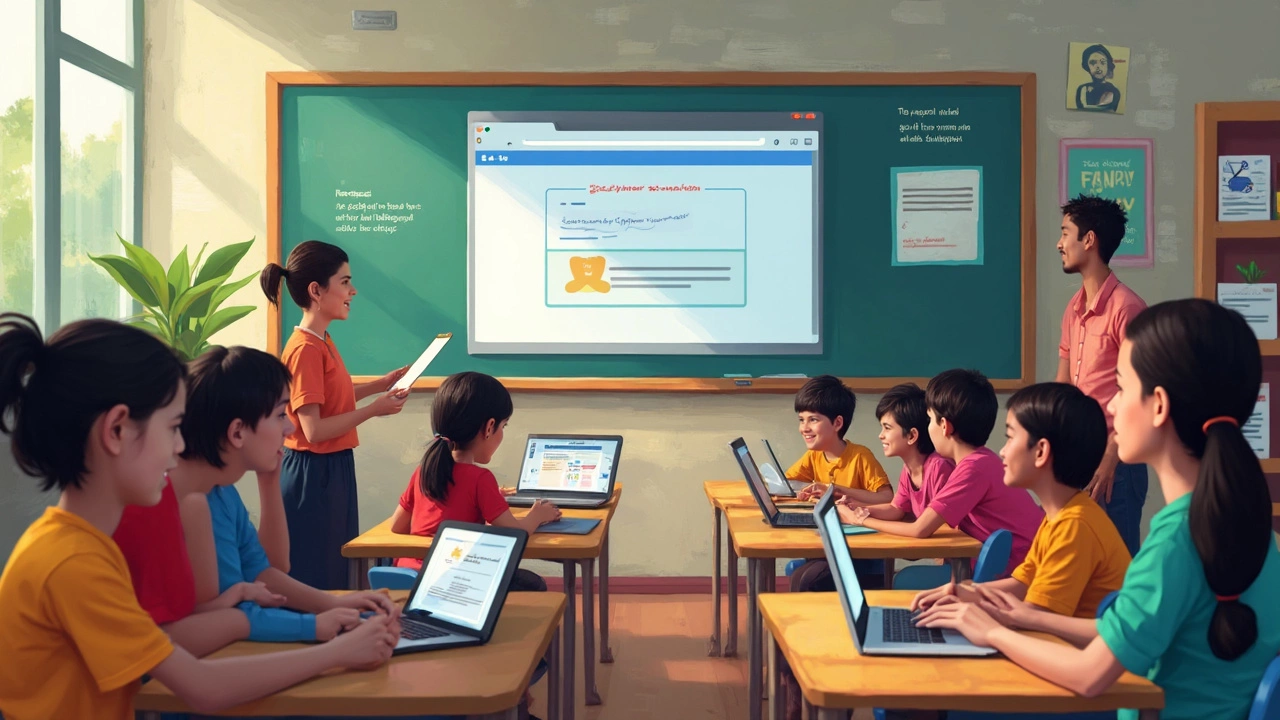Online Learning Platform Selector
Find your best fit
Answer 3 questions to discover which platform matches your needs.
When schools shut down in 2020, millions of students and teachers scrambled to find a way to keep learning going. Five years later, online classes aren’t a backup plan anymore-they’re the default for many. But if you ask someone what platform they use for online classes, the answer isn’t always the same. Some swear by Zoom. Others rely on Google Classroom. A few still use old-school LMS systems like Moodle. So what’s actually the most used platform for online classes today?
Google Classroom dominates K-12 education worldwide
For elementary and high school students, Google Classroom is the clear leader. It’s free, simple, and works on any device with a browser. Schools don’t need to buy licenses, train staff extensively, or install software. Teachers can create assignments, post announcements, and grade papers-all inside Gmail and Google Drive. A 2024 survey by the U.S. Department of Education found that 78% of public schools in the United States use Google Classroom as their main platform. The numbers are even higher in countries like India, Brazil, and Indonesia, where Chromebooks are widely distributed and internet access is often limited to mobile devices.
Why does it work so well? Because it doesn’t try to do everything. It doesn’t have complex video conferencing tools built in. Instead, it connects directly to Google Meet, which handles live sessions. That makes it lightweight and reliable even on slow connections. Teachers who’ve switched from Moodle or Blackboard say the biggest win is time saved. No more uploading PDFs to a clunky portal. Just drag and drop from Drive, assign it, and students get it instantly.
Zoom is the go-to for live teaching
If you’re looking for real-time interaction-group discussions, Q&A sessions, breakout rooms-Zoom is still the most popular tool. It’s not a learning management system. It’s a video call platform. But because it’s so easy to use and integrates with almost everything, it’s become the default for live classes at universities, corporate training centers, and even private tutors.
In higher education, Zoom is often paired with Canvas or Blackboard. Professors post lecture recordings and readings on the LMS, then use Zoom for weekly live sessions. A 2025 report from Educause found that 82% of U.S. colleges still use Zoom for synchronous classes, even though many now offer hybrid or fully asynchronous options. The reason? Students and instructors alike say face-to-face interaction, even virtual, keeps engagement up.
Zoom’s free tier allows meetings up to 40 minutes, which works for short class periods. Paid plans unlock longer sessions, recording storage, and attendance tracking-features schools are happy to pay for. Its reliability during peak hours (8 a.m. to 5 p.m. local time) has improved dramatically since 2020, and most institutions now have dedicated IT support for it.

Microsoft Teams is growing fast in enterprise and public schools
Microsoft Teams didn’t start as an education tool. It was built for business collaboration. But because it comes bundled with Microsoft 365, it’s now the default platform in many government-funded schools and universities, especially in Europe and North America.
Canada, for example, has seen a sharp rise in Teams adoption since 2022. Provincial education ministries signed enterprise deals with Microsoft, giving every student and teacher free access to Teams, OneNote, and Word Online. In British Columbia, over 85% of public school districts now use Teams as their primary communication hub. It’s not just for video calls-it’s for calendars, assignments, group chats, and even digital report cards.
Teams has an edge in environments where students already use Windows PCs or Office apps. It integrates seamlessly with OneDrive, SharePoint, and Power BI. For teachers who grew up with Microsoft Word and Excel, the learning curve is nearly flat. And unlike Google Classroom, Teams supports advanced accessibility features like live captioning and screen reader compatibility out of the box.
Moodle and Canvas still hold ground in universities and private institutions
While Google and Microsoft dominate the consumer side, Moodle and Canvas are still the backbone of university-level online learning. Moodle is open-source, which means universities can customize it to fit their exact needs. It’s used by over 100 million learners globally, mostly in Europe, Australia, and parts of Asia.
Canvas, developed by Instructure, is the preferred choice in many U.S. universities. It’s slick, modern, and mobile-friendly. It has built-in grading tools, rubrics, and analytics that help instructors track student progress in real time. Unlike Google Classroom, Canvas supports complex assignments like peer reviews, timed exams, and plagiarism detection through Turnitin.
But here’s the catch: both require technical staff to maintain. If your school doesn’t have an IT team, these platforms become a burden. That’s why many smaller colleges and private academies are switching to Google or Microsoft-less maintenance, more reliability.

Why no single platform wins everywhere
There’s no universal winner because different users have different needs. A 10-year-old in rural India doesn’t need advanced analytics. They need a simple app that works on a $50 Android phone. A university professor needs to grade 300 essays with detailed feedback. A corporate trainer needs to track completion rates for compliance.
Most schools use a mix. Google Classroom for assignments. Zoom for live sessions. YouTube for recorded lectures. WhatsApp for reminders. That’s the reality. The most used platform isn’t one-it’s a stack.
But if you had to pick the single most used platform across all levels of education, from kindergarten to university, the answer is Google Classroom. It’s the most widely adopted, easiest to deploy, and most accessible. It doesn’t require licenses, complex setup, or technical training. For millions of students around the world, it’s the first thing they open when they log in for class.
What’s next? AI is changing the game
The next big shift won’t be about which platform you use-it’ll be about what the platform can do for you. AI-powered tools are now being built into all major platforms. Google Classroom can auto-generate quiz questions from a lecture transcript. Microsoft Teams can summarize meeting notes and assign follow-ups. Canvas uses AI to flag students who might be falling behind based on assignment patterns.
These features aren’t magic. They’re based on data-attendance, submission times, quiz scores, even how long a student spends reading a PDF. Schools that use these tools report fewer dropouts and higher engagement. But they also raise privacy questions. Who owns that data? Can parents see it? Are students being tracked too closely?
For now, the platform you choose still matters. But soon, the real question won’t be what platform you use-it’ll be how smart it is.
Is Google Classroom the most used platform for online classes?
Yes, Google Classroom is the most used platform for online classes overall, especially in K-12 education. It’s free, works on any device, and integrates with Google Meet and Drive. Over 75% of public schools in the U.S. and a majority in developing countries rely on it as their main learning tool.
Is Zoom better than Google Classroom for online classes?
Zoom isn’t a learning platform-it’s a video conferencing tool. It’s better than Google Classroom for live interaction, breakout rooms, and real-time teaching. But it doesn’t handle assignments, grading, or course organization. Most schools use both: Google Classroom for assignments and Zoom for live classes.
Do universities use Google Classroom?
Most universities don’t use Google Classroom for full courses. They prefer Canvas, Moodle, or Blackboard because those platforms support advanced grading, plagiarism checks, and complex assessments. Google Classroom is too basic for college-level work. But some professors use it for short modules, summer programs, or supplemental materials.
Why do some schools still use Moodle?
Moodle is open-source, so schools can customize it to fit their exact needs. It’s popular in Europe and Australia because it gives institutions full control over data and features. But it requires technical staff to maintain. Many schools are moving away from it because it’s harder to use than Google Classroom or Microsoft Teams.
Is Microsoft Teams replacing Google Classroom in schools?
In some places, yes-especially in government-funded schools in Canada, the UK, and parts of Europe where Microsoft 365 licenses are already provided. Teams offers deeper integration with Office apps and better accessibility tools. But Google Classroom still leads globally because it’s free and works on low-end devices. Neither has fully replaced the other.


